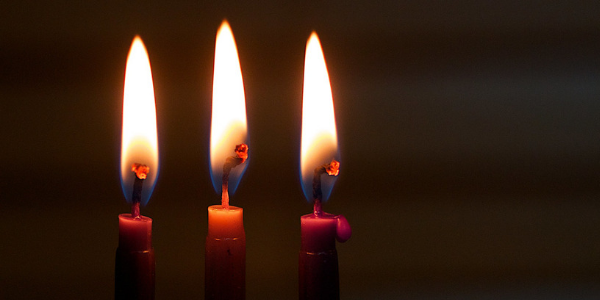
Most people that work magick have heard the admonishment. “Before you cast that spell, remember the Law of Three!” The Law of Three, for any newcomers, is an ethical system found in Wicca and similar belief systems; the belief that if you do good works, three times the good will come back to you, and if you do bad, three times the bad will return.
The more literal-minded can already recognize some of the problems with this admonishment. First, how in Hades do you measure what would be three times better or three times worse on magick and emotion-driven energies? Second, how did this law come into being? Who enforces it? If it really operated like a universal constant, wouldn’t any reaction triggered be equal and opposite, rather than three times the intensity?
…has anyone kept track of this phenomena?
Challenging mainstreamed Wiccan concepts like the Law of Three and karma can feel like Daenerys Targaryen taking on Dothraki misogynist tradition: After so many “it is known”s there is a temptation to set the entire enclave on fire. However, arson does little to settle disputes, and so instead I use my words. This is especially the case when exploring whether something like a magical law is abstract or real. It is even more the case when my own perspective is “it is real, but that won’t matter soon.”
The history of the Law of Three
In 1975, at the beginning of Wicca’s cultural crest, a poem extolling the Law of Three was published in Green Egg Magazine.1 The poem mentioned several folkways. It charmed enough readers to make it into their personal Books of Shadows or similar knowledge scrapbooks, and thus became tradition.
Around 1995, this poem and many variations of the Wiccan Rede made its way to spinning pentacle bedazzled websites sans attribution. People typing “Wicca” into pre-Google search engines found Doreen Valiente’s Charge of the Goddess2 and the Rede of the Wicae by (ostensibly) Adriana Porter. Along with a laundry list of proverb-like admonishments, one catchy line near the end admonishes, “Mind the Threefold Law ye should – Three times bad an’ three times good.”3
With relatively little to compare the idea to, newer spiritual seekers with no other anchoring in magical tradition accepted this Law of Three without question.
It became virtually catechized into Wiccan tradition. Thus, those learning Wicca as their first exposure to magick gave their energy of belief to the Law of Three and its misappropriation of karma. Most didn’t look deeper.
Wicca became more public just as the Satanic Panic4 began to rise. In the 1980s, thanks to bad application of regressed memory therapy, several children “recalled” being subjected to lurid Satanic ritual abuse. While these ritual abuse cases turned out to be untrue, it did not repair the damage these tales did to fringe spiritual groups. Suddenly, witches had to fight for their fundamental religious freedoms, and they needed better public relations to do it. Laurie Cabot established the Witches’ Anti-Defamation League, and the Law of Three became an important tool in soothing frightened neighbours about the witch next door. The core message sent, taken up by many a new-minted Pagan, was that witches were absolutely not Satanists, and in fact, they practices a set of morally superior values that made it clear that witches are so not Satanists.
This messaging did a few things that we are still untangling from. First, it seeded the idea that Wiccans, i.e. mostly Caucasian and West European witches, were the only “real” witches. Discernment of missing phrases such as “all” or “none” has never been the forte of the general public; while this was likely never the actual intention of those doing anti-discrimination work, privilege is tricky, especially when you’re in the process of creating something you literally aren’t able to see.
This messaging then in turn implied that Wicca got the biggest say in what witchcraft is, how it is practised, and under what rules magick operates. While never spoken directly, if you violated those rules – sometimes by being something other than white, European, or accommodating to Christian culture – you were Satanic. The Law of Three, used by Wiccans as a sort of moral and metaphysical code, suddenly became fed by people outside of Wicca also adopting and investing belief in the Law of Three. The lack of discernment around Satanism to this day bears discussion, but perhaps that should come from someone actually diabolic.
This re-labelling of anything that was magical but not Wicca as “negative magick” or “immoral” or “outright Satanism” served to suppress and oppress other magical practices and traditions. The Witches’ Anti-Discrimination League did not, to my knowledge, welcome the practices of African diaspora. Combined with Wicca’s definitions of witchcraft only including itself, (Or a general, non-specific Pagan so long as it could be westernized and non-threatening) this created a pathway in cultural consciousness to feed the growing egregore of the Law of Three. So many people truly believed Wicca was the whole of witchcraft, and with it that the Law of Three regulated all of it, that the Law of Three became something more than a law.

Egregore
For those unfamiliar with the concept, an egregore is a spirit or intelligence formed from the energies of collective belief. Over time, with a large enough continuous energy feed, an egregore can function independently. Some egregores do come into being without conscious intention. If enough people share a belief in a specific imagined entity, a spirit can form from it.
Covens and lodges routinely create intentional egregores. These entities protect their group, hide their secrets, or serve as energy storage cells for group members to draw on in hard times. This practice is so common that some groups only see themselves as legitimate after forming an egregore. When the group disbands, disbanding that egregore is considered an important part of the cleanup work.
While often enough such created spirits might have a face, or legs, or be ambulatory, it can even manifest as a meme, or as a very strong shared belief. I am of the opinion, partially intuited and partially experienced, that the Law of Three is an egregore. It is unclear to me whether its semi-sentient existence is intentional or accidental.
What I can see from my position as a former Wiccan is that the rigour of its moral intrusions on non-Wiccan witches has faded in recent years. I also think it has no business pestering witches outside of its fold, but it’s like fighting off the prevalence of Christianity in western over-culture; you might not celebrate Christmas but the neighbourhood carollers just don’t care.
By the time I started practicing Wicca, the beast of the egregore was on the move. It did seem, when I compared notes with others, like everyone exposed to the idea of the Law of Three experienced regulation. This happened even to non-Wiccan workers. Any negative work any of us in that social sphere did resulted in a slew of bad luck. This even happened when the negative work was, without question, the best choice.
While I now understand a great deal more about magical kickback and cleanup, the non-Wiccan workers already had those practices and considerations in place – and yet they too experienced that mysterious, regulating force.
In one case, I knew a man that worked Psalms as magick. He had asked my thoughts on a run of increasing bad luck he and his family were experiencing. When I brought up the Law of Three and my belief it applied to all magick, not just Wicca, I saw fear in his eyes. His family worked with both hands…and they especially used that hand for their clients. His parents hadn’t dealt with those strange runs of bad luck when they were our age – and they were mystified that he was.
Losing its power
Racial and identity tensions have done a great deal to weaken the grip of this particular egregore. Other witches from non-European cultures began speaking up, with force. While the Law of Three may not have been intended as a tool of racist oppression, it often manifested in discussions as a paternal “knowing best”, in a very white man’s burden sort of way.
Those workers from those practices had no patience with this karma co-option nonsense. As more people started to say, “Wait a goddamn minute, I’m not Wiccan and I didn’t agree to this,” I heard less from my cohorts about mysterious strings of bad luck when they placed a hex or curse. For those that never signed up for Wicca, or like me, signed out, the grip of the Law of Three in recent years has crumbled like Tinkerbell when someone says they don’t believe in faeries. I am even seeing it apply with less force to Wiccans and others who agree to it. It appears that the Law of Three’s grip is loosening, its power is fading, or someone wove a consent clause up in that thing.
I have little way of knowing where it came from. Perhaps some well-intentioned yet excessively authoritarian high priestess decided to cone up a big ball of energy, name it “Law of Three”, and turn it loose on the entire magical population. Certainly, such hubris does exist in magical communities. We magical types are always in some dance with our egos. Perhaps the Law of Three grew like city spirits do, where a large enough group of people shared a Wiccan or Pagan identity, and it happened to be just enough of a shared value to sprout legs and start kicking people.
Like Tinkerbell, it may be losing its power as more and more people say they don’t believe in it.

Conclusion
I once thought I saw wisdom in the Law of Three – what better way to keep me in check? I’m better at magick now than when I started some twenty odd years back, and I have a much better understanding of the psycho-emotional states that power spellcasting. I also like myself more now.
Because I trust myself, I have opted out of feeding the egregore of the Law of Three, simply because I think too well of myself to believe I need an invisible giant nanny. Other workers may have disengaged for other reasons: “I never consented”, “This makes no sense”, “How on earth would you measure three times better or worse anyway”, “Wow, that’s some privilege-rooted nonsense”, and so on.
Bit by bit, the seeking toe of the Law of Three has blunted. Soon, it may be little more than a memory, an old piece of lore set aside when we found better ways to own our power.
Image credits: Alan Levine, fs999, Kat…
- Green Egg Magazine,http://www.greeneggemagazine.com/ [↩]
- “The Charge of the Goddess” doreenvaliente.com [↩]
- “Rede of the Wicae” Inona’s Witchery inona.tripod.com [↩]
- Romano, Aja. The history of Satanic Panic in the US — and why it’s not over yet. Vox vox.com [↩]







